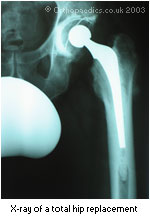


o r t h o p a e d i c s . c o . u k

| +home | |
| +news | |
| +research | |
| +patient infomation | |
| +the clinic | |
| +the surgeon | |
| +sport physiotherapy | |
| +sports advice | |
| +products | |
| +resources | |
| +contact | |
| +maps & directions | |
| +site map |
|
The Bristol Orthopaedic |
Total Hip Arthroplasty - Introduction
What is Total Hip Arthroplasty?
Total hip arthroplasty is undertaken for hip arthritis. With age or following rheumatoid arthritis the weight bearing surfaces of the hip joint become worn away. They are no longer smooth and free running and this leads to stiffness and pain. Eventually the joint wears away to such an extent that the bone of the femur grinds on the bone of the pelvis or acetabulum. Joint replacement is then required. New technology, new techniques and new types of hip replacements have made this procedure in recent years very successful and the results are now very reliable.
When the arthritis is severe in a younger patient the hip may be replaced without the use of cement. This is dependent on the use of special metal components with porous surfaces or coatings, which allow the bone to grow into the metal surface and thereby, stabilise the new replacement joint. This technique does require the use of crutches in the early postoperative period.

A total hip replacement replaces the surfaces of the hip with plastic and metal components. The femoral replacement is a smooth metal component which fits snugly into the inside of the upper end of the thigh or femur bone. The socket or acetabulum of the hip in the side of the pelvis is replaced by a replacement cup. This is usually made of high density polyethylene which is cemented into place or alternately in younger patients a metal cup which is inserted without cement. In certain circumstances special components may be "press fitted" to the bones without the additional use of cement. These components use micro-porous metallic surfaces and may have an additional hydroxyapatite coating to promote osteo-integration or bonding to the bone. More recently a resurfacing hip replacement has become popular in younger patients which uses minimally invasive surgical techniques to replace only the surface of the hip joint. This avoids excessive removal of bone and may be considered a more conservative procedure. The early results of this type of surgery have been encouraging
< BACK to Total Hip Arthoplasty Index | NEXT: Indications / Contra - indications >
Related Links..
+ How to make an appointment
+ Total Hip Arthroplasty - see all links
+ Patient Information Home
+ See the clinic
+ More about Mr Johnson
+ top
© The Bristol Orthopaedic & Sports Injury Clinic 2003. privacy | contact | Powered By Create Medical